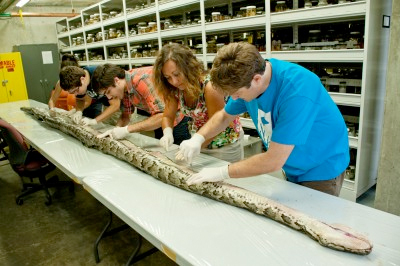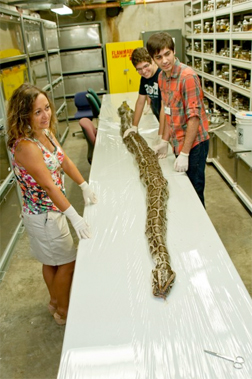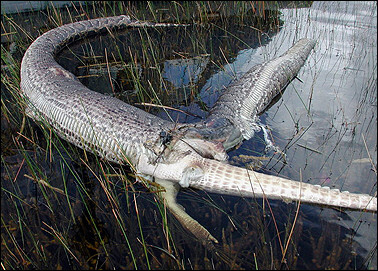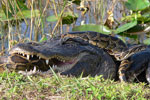 On Aug. 10, 2012, researchers at the Florida Museum of Natural History on the University of Florida campus examine the internal anatomy of the largest Burmese python found in Florida to date. The 17-foot-7-inch snake weighed 164 pounds and carried 87 eggs in its oviducts, a state record. Following scientific investigation, the snake will be mounted for exhibition at the museum for about five years, and then returned for exhibition at Everglades National Park. Pictured are Rebecca Reichart (from left), Leroy Nunez, Nicholas Coutu, Claudia Grant and Kenneth Krysko. (University of Florida photo by Kristen Grace/Florida Museum of Natural History) |
Researchers in Florida have documented the biggest snake ever found in Florida. But the snake is an invader — it’s not native.
The Burmese python measures 17 feet, 7 inches long and weighs 164.5 pounds, according to the University of Florida. The snake was brought into the Florida Museum from Everglades National Park as part a project to control the population of the invasive species, which is devastating native wildlife in the Everglades.
 Researchers at the Florida Museum of Natural History on the University of Florida campus prepare to examine the internal anatomy of a 17-foot-7-inch Burmese python, the largest found in Florida to date, on Aug. 10, 2012. Pictured are Claudia Grant (from left), Leroy Nunez and Nicholas Coutu. (University of Florida photo by Kristen Grace/Florida Museum of Natural History) |
Researchers killed the snake and are now analyzing its stomach contents for clues on its diet. Burmese pythons are known to feast on prey on native rodents, fish, birds, and deer as well as larger animals alligators.
“This thing is monstrous, it’s about a foot wide,” said Florida Museum herpetology collection manager Kenneth Krysko in a statement. “It means these snakes are surviving a long time in the wild, there’s nothing stopping them and the native wildlife are in trouble.”
“A 17.5-foot snake could eat anything it wants. By learning what this animal has been eating and its reproductive status, it will hopefully give us insight into how to potentially manage other wild Burmese pythons in the future. It also highlights the actual problem, which is invasive species.”
The Burmese python was introduced to Florida via the pet trade in the 1970s and was first found in the Everglades in 1979. Since then its population has boomed. In the Everglades it has abundant prey and no natural predators.
“They were here 25 years ago, but in very low numbers and it was difficult to find one because of their cryptic behavior,” Krysko said. “Now, you can go out to the Everglades nearly any day of the week and find a Burmese python. We’ve found 14 in a single day.”
 Michael Barron of the National Park Service took this picture of a carcass of an alligator as it protrudes out from the body of a dead Burmese python in Everglades National Park, Florida. |
The contents of the just-discovered giant python reflect the challenges controlling its population. A record 87 eggs were discovered in the snake.
“I think one of the important facts about this animal is its reproductive capability,” said Skip Snow, a wildlife biologist at Everglades National Park. “There are not many records of how many eggs a large female snake carries in the wild. This shows they’re a really reproductive animal, which aids in their invasiveness.”
Snow said understanding the snake’s biology could help experts slow its spread.
Related articles
‘Penis snake’ discovered in Brazil is actually a rare species of amphibian
(08/02/2012) A creature discovered by engineers building a dam in the Amazon is a type of caecilian, a limbless amphibian that resembles an earthworm or as some are noting, part of the male anatomy.
Invasion!: Burmese pythons decimate mammals in the Everglades
(01/30/2012) The Everglades in southern Florida has faced myriad environmental impacts from draining for sprawl to the construction of canals, but even as the U.S. government moves slowly on an ambitious plan to restore the massive wetlands a new threat is growing: big snakes from Southeast Asia. A new paper in the Proceedings of the National Academy of Sciences (PNAS) has found evidence of a massive collapse in the native mammal population following the invasion of Burmese pythons (Python molurus bivittatus) in the ecosystem. The research comes just after the U.S. federal government has announced an importation ban on the Burmese python and three other big snakes in an effort to safeguard wildlife in the Everglades. However, the PNAS study finds that a lot of damage has already been done.
U.S. implements snake ban to save native ecosystems

(01/25/2012) Last week the U.S. Fish and Wildlife Service (USFWS) announced it was banning the importation and sale across state lines of four large, non-native snakes: the Burmese python (Python molurus bivittatus), the yellow anaconda (Eunectes notaeus), and two subspecies of the African python (Python sebae). Although popular pets, snakes released and escaped into the wild have caused considerable environmental damage especially in the Florida Everglades.
Aloha, and welcome to the planet’s extinction capital

(11/07/2011) Hawaii evokes images of a tropical paradise where fragrant flowers, vivid colors, exotic plants, birds, and
fish abound. Unfortunately, much of Hawaii’s original native flora and fauna has disappeared since the
arrival of Europeans in the 18th Century. Hawaii now has the dubious distinction as having become the
planet’s extinction capital, having lost more than 55 endemic species (mostly native forest birds) which
account for nearly one third of recorded of bird extinctions since the 1700s.
Florida announces python hunt following snake invasion
(07/16/2009) Florida has authorized a cull of Burmese pythons that have invaded the Everglades and other wetland areas, reports the Associated Press.
Python explodes after swallowing 6-foot alligator in Florida Everglades
(10/05/2005) The National Park Service released photos that show the carcass of an American alligator that was almost swallowed by a Burmese python.